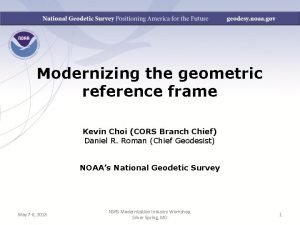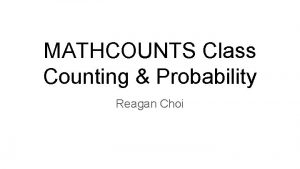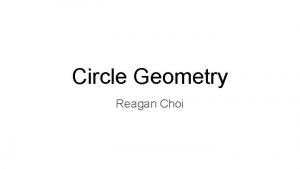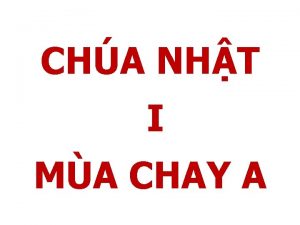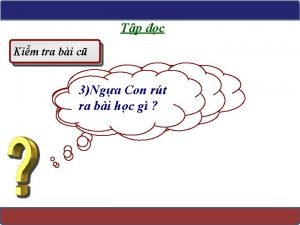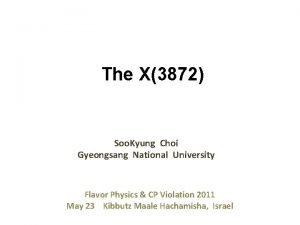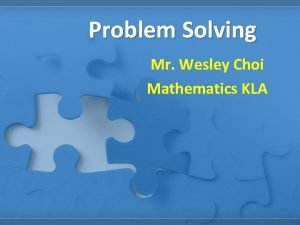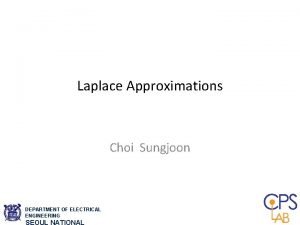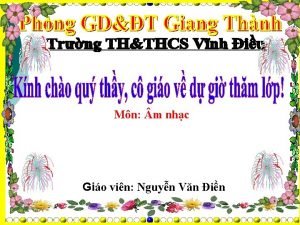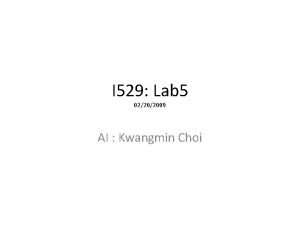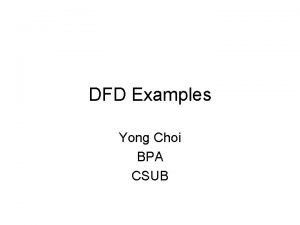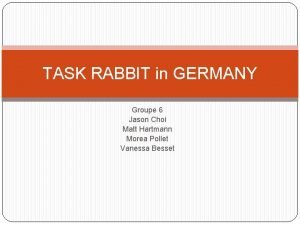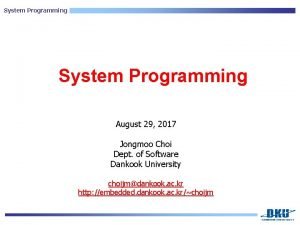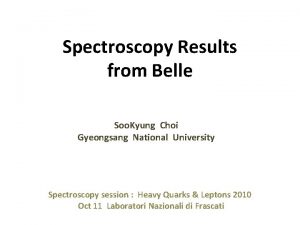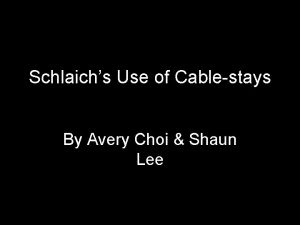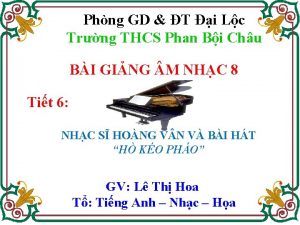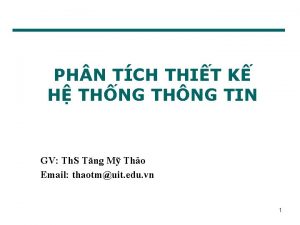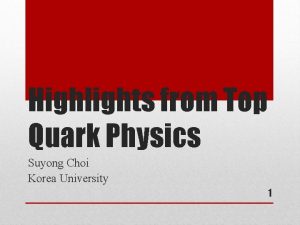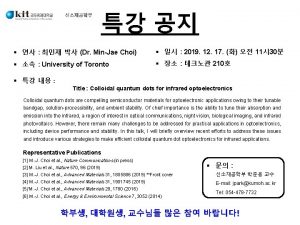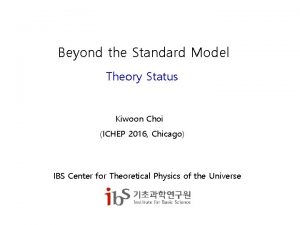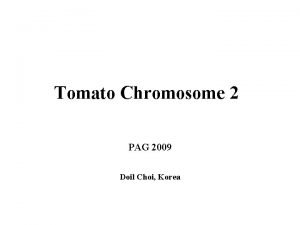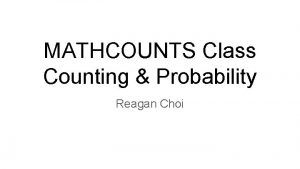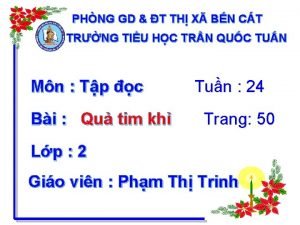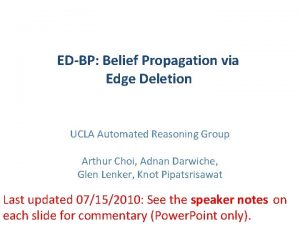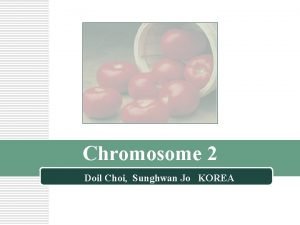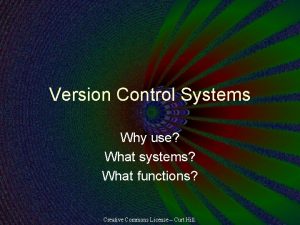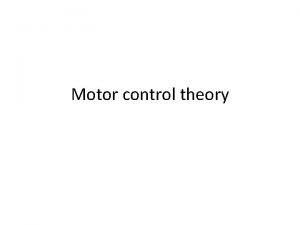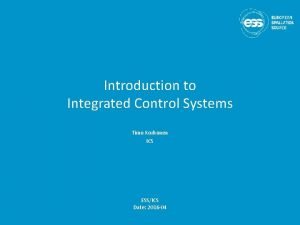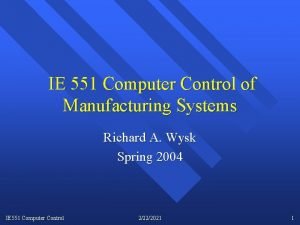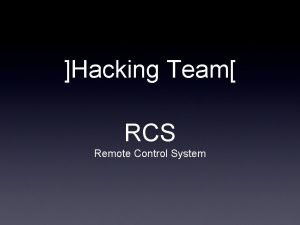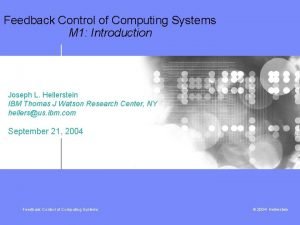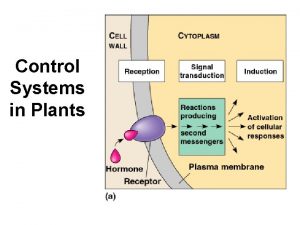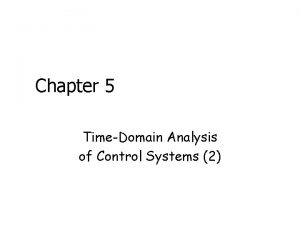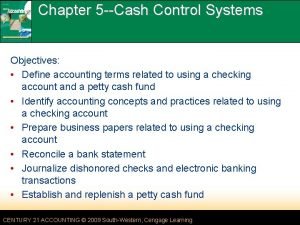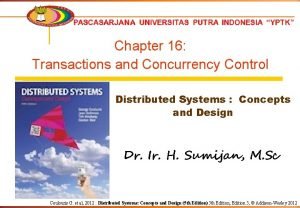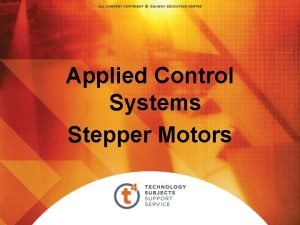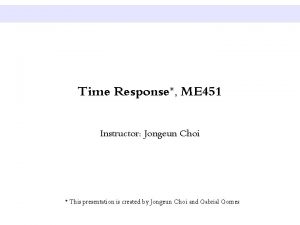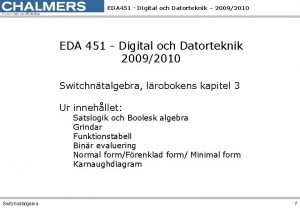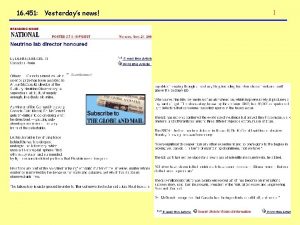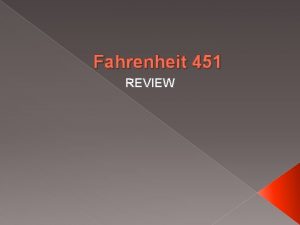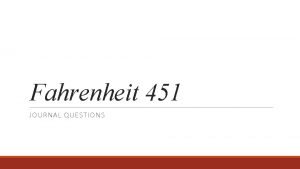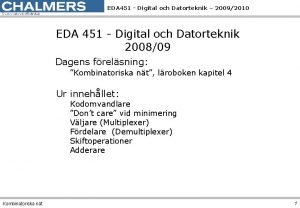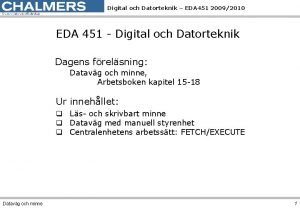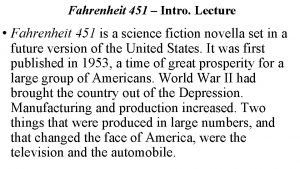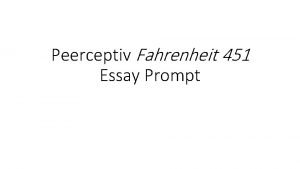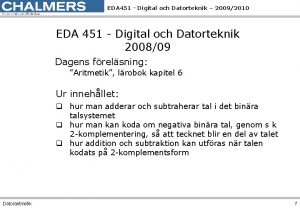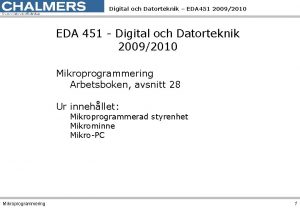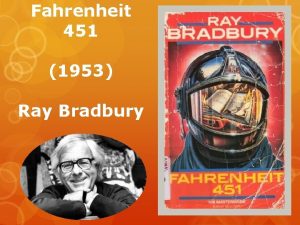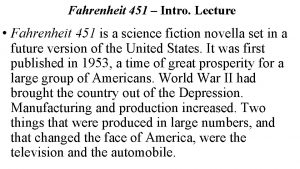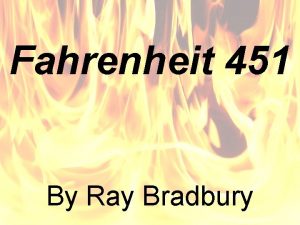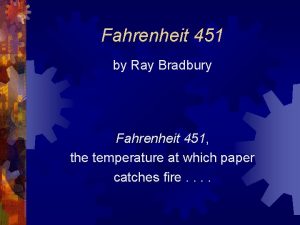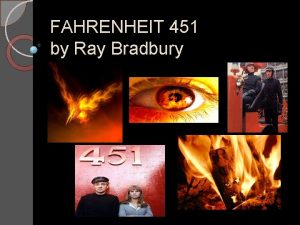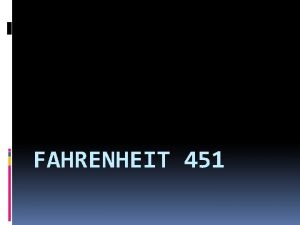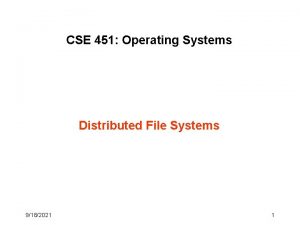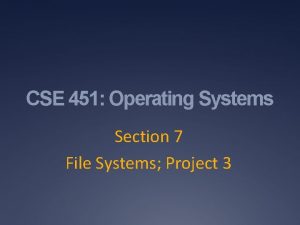ME 451 Control Systems Jongeun Choi Ph D













































![Matlab Simulation § G=tf([0 5], [1 2]); § impulse(G) § step(G) ME 451 S Matlab Simulation § G=tf([0 5], [1 2]); § impulse(G) § step(G) ME 451 S](https://slidetodoc.com/presentation_image_h/aafee4f09ed209bb2d880525917f12db/image-46.jpg)



![Matlab Simulation § zeta = 0. 3; wn=1; § G=tf([wn], [1 2*zeta*wn wn^2]); § Matlab Simulation § zeta = 0. 3; wn=1; § G=tf([wn], [1 2*zeta*wn wn^2]); §](https://slidetodoc.com/presentation_image_h/aafee4f09ed209bb2d880525917f12db/image-50.jpg)


![Matlab Simulation § zeta = 0. 3; wn=1; G=tf([wn], [1 2*zeta*wn wn^2]); § step(G) Matlab Simulation § zeta = 0. 3; wn=1; G=tf([wn], [1 2*zeta*wn wn^2]); § step(G)](https://slidetodoc.com/presentation_image_h/aafee4f09ed209bb2d880525917f12db/image-53.jpg)







- Slides: 60

ME 451: Control Systems Jongeun Choi, Ph. D. Assistant Professor Department of Mechanical Engineering, Michigan State University http: //www. egr. msu. edu/classes/me 451/jchoi/ http: //www. egr. msu. edu/jchoi@egr. msu. edu

Course Information (Syllabus) § Lecture: 2205 EB, Sections: 5, 6, 7, 8, MWF 12: 40 -1: 30 pm § Class website: http: //www. egr. msu. edu/classes/me 451/jchoi/ § Laboratory website: http: //www. egr. msu. edu/classes/me 451/radcliff/lab § Class Instructor: Jongeun Choi, Assisntant Professor, 2459 EB, Email: jchoi@egr. msu. edu § Office Hours of Dr. Choi: 2459 EB, MW 01: 40 -2: 30 pm, Extra hours by appointment only (via email) § Laboratory Instructor: Professor C. J. Radcliffe, 2445 EB, Phone: (517)-355 -5198 § Required Text: Feedback Control Systems, C. L. Phillips and R. D. Harbor, Prentice Hall, 4 th edition, 2000, ISBN 0 -13 -949090 -6 § Grading: Homework (15%), Exam 1 (15%), Exam 2 (15%), Final § Note Exam(comprehensive) (30%), Laboratory work (25%) § Homework will be done in one week from the day it is assigned. § 100% laboratory attendance and 75% marks in the laboratory reports will be required to pass the course. § Laboratory groups for all sections will be posted on the door of 1532 EB. ME 451 S 07 2

About Your Instructor § Ph. D. (‘ 06) in Mechanical Engineering, UC Berkeley § Major field: Controls, Minor fields: Dynamics, Statistics § M. S. (‘ 02) in Mechanical Engineering, UC Berkeley § B. S. (‘ 98) in Mechanical Design and Production Engineering, Yonsei University at Seoul, Korea § Research Interests: Adaptive, learning, distributed and robust control, with applications to unsupervised competitive algorithms, self-organizing systems, distributed learning coordination algorithms for autonomous vehicles, multiple robust controllers, and micro-electromechanical systems (MEMS) § 2459 EB, Phone: (517)-432 -3164, Email: jchoi@egr. msu. edu, Website: http: //www. egr. msu. edu/~jchoi/ ME 451 S 07 3

Motivation § A control system is an interconnected system to manage, command, direct or regulate some quantity of devices or systems. § Some quantity: temperature, speed, distance, altitude, force § Applications § Heater, hard disk drives, CD players § Automobiles, airplane, space shuttle § Robots, unmanned vehicles, ME 451 S 07 4

Open-Loop vs. Closed-Loop Control § Open-loop Control System § Toaster, microwave oven, shoot a basketball Manipulated variable Signal Input Controller output Plant (Actuator) § Calibration is the key! § Can be sensitive to disturbances ME 451 S 07 5

Open-Loop vs. Closed-Loop Control § Closed-loop control system § Driving, cruise control, home heating, guided missile Signal Input + Manipulated variable Error Controller - output Plant (Actuator) Sensor ME 451 S 07 6

Feedback Control § Compare actual behavior with desired behavior § Make corrections based on the error difference § The sensor and the actuator are key elements of a feedback loop § Design control algorithm Signal Input Error output Control + - Algorithm Actuator Plant Sensor ME 451 S 07 7

Common Control Objectives § Regulation (regulator): maintain controlled output at constant setpoint despite disturbances § Room temperature control, § Cruise control § Tracking (servomechanism): controlled output follows a desired time-varying trajectory despite disturbances § Automatic landing aircraft, § Hard disk drive data track following control ME 451 S 07 8

Control Problem § Design Control Algorithm § such that the closed-loop system meets certain performance measures, and specifications § Performance measures in terms of § Disturbance rejection § Steady-state errors § Transient response § Sensitivity to parameter changes in the plant § Stability of the closed-loop system ME 451 S 07 9

Why the Stability of the Dynamical System? § Engineers are not artists: § Code of ethics, Responsibility § Otherwise, Tacoma Narrows Bridge: Nov. 7, 1940 Wind-induced vibrations ME 451 S 07 Catastrophe 10

Linear (Dynamical) Systems § H is a linear system if it satisfies the properties of superposition and scaling: § Inputs: § Outputs: § Superposition: § Scaling: § Otherwise, it is a nonlinear system ME 451 S 07 11

Why Linear Systems? § Easier to understand obtain solutions § Linear ordinary differential equations (ODEs), § Homogeneous solution and particular solution § Transient solution and steady state solution § Solution caused by initial values, and forced solution § Add many simple solutions to get more complex ones (Utilize superposition and scaling!) § Easy to check the Stability of stationary states (Laplace Transform) § Even nonlinear systems can be approximated by linear systems for small deviations around an operating point ME 451 S 07 12

Convolution Integral with Impulse § Input signal u(t) ME 451 S 07 13

Output Signal of a Linear System § Input signal § Output signal Superposition! def: impulse response def: convolution def: causality ME 451 S 07 14

Impulse Response ME 451 S 07 15

Causal Linear Time Invariant (LTI) System § A causal system (a physical or nonanticipative system) is a system where the output only depends on the input values § Thus, the current output can be generated by the causal system with the current and past input values § Causal LTI impulse response § Thus, we have ME 451 S 07 16

Causal System (Physically Realizable) past future current ME 451 S 07 System past future current 17

Causal System? § Derivative operator (input: position, output: velocity) § Integral operator (input: velocity, output: position) ME 451 S 07 18

Complex Numbers § Ordered pair of two real numbers § Conjugate § Addition § Multiplication ME 451 S 07 19

Complex Numbers § Euler’s identity § Polar form § Magnitude § Phase ME 451 S 07 20

ME 451 S 07 21

Transfer Function: Laplace Transform of Unit Impulse Response of the System § Input signal: § Output signal: def: Transfer Function § Take Laplace transform of the impulse response ME 451 S 07 22

Frequency Response § Input § We know § Complex numbers Magnitude Phase shift ME 451 S 07 23

Frequency Response ME 451 S 07 24

The Laplace Transform (Appendix B) § Laplace transform converts a calculus problem (the linear differential equation) to an algebra problem § How to Use it: § Take the Laplace transform of a linear differential equation § Solve the algebra problem § Take the Inverse Laplace transform to obtain the solution to the original differential equation def: Laplace transform def: Inverse Laplace transform ME 451 S 07 25

The Laplace Transform (Appendix B) § Laplace Transform of a function f(t) § Convolution integral ME 451 S 07 26

Properties of Laplace Transforms (page 641 -643) § Linearity § Time Delay Non-rational function ME 451 S 07 27

Properties of Laplace Transforms § Shift in Frequency § Differentiation ME 451 S 07 28

Properties of Laplace Transforms § Differentiation ( in time domain , s in Laplace domain) § Integration ( in time domain , 1/s in Laplace domain) ME 451 S 07 29

Laplace Transform of Impulse and Unit Step § Impulse § Unit Step ME 451 S 07 30

Unit Ramp ME 451 S 07 31

Exponential Function ME 451 S 07 32

Sinusoidal Functions ME 451 S 07 33

Partial-fraction Expansion (Text, page 637 -641) § F(s) is rational, realizable) realizable condition (d/dt is not zeros poles ME 451 S 07 34

Cover-up Method § Check the repeated root for the partial-fraction expansion (page 638) ME 451 S 07 35

Example § Obtain y(t)? ME 451 S 07 36

Transfer Function § Defined as the ratio of the Laplace transform of the output signal to that of the input signal (think of it as a gain factor!) § Contains information about dynamics of a Linear Time Invariant system § Time domain Laplace transform Inverse Laplace transform § Frequency domain ME 451 S 07 37

Mass-Spring-Damper System § ODE § Assume all initial conditions are zero. Then take Laplace transform, Output Transfer function Input ME 451 S 07 38

Transfer Function § Differential equation replaced by algebraic relation Y(s)=H(s)U(s) § If U(s)=1 then Y(s)=H(s) is the impulse response of the system § If U(s)=1/s, the unit step input function, then Y(s)=H(s)/s is the step response § The magnitude and phase shift of the response to a sinusoid at frequency is given by the magnitude and phase of the complex number § Impulse: § Unit step: ME 451 S 07 39

Kirchhoff’s Voltage Law § The algebraic sum of voltages around any closed loop in an electrical circuit is zero. ME 451 S 07 40

Kirchhoff’s Current Law § The algebraic sum of currents into any junction in an electrical circuit is zero. ME 451 S 07 41

Theorems § Initial Value Theorem § Final Value Theorem § If all poles of s. F(s) are in the left half plane, then ME 451 S 07 42

DC Gain of a System § DC gain: the ratio of the steady state output of a system to its constant input (1/s) § For a stable transfer function § Use final value theorem to compute the steady state of the output ME 451 S 07 43

Pure Integrator § Impulse response § Step response ME 451 S 07 44

First Order System § Impulse response § Step response § DC gain: (Use final value theorem) ME 451 S 07 45
![Matlab Simulation Gtf0 5 1 2 impulseG stepG ME 451 S Matlab Simulation § G=tf([0 5], [1 2]); § impulse(G) § step(G) ME 451 S](https://slidetodoc.com/presentation_image_h/aafee4f09ed209bb2d880525917f12db/image-46.jpg)
Matlab Simulation § G=tf([0 5], [1 2]); § impulse(G) § step(G) ME 451 S 07 46

Second Order Systems with Complex Poles § Assume § Poles: ME 451 S 07 47

Second Order Systems with Complex Poles ME 451 S 07 48

Impulse Response of the 2 nd Order System ME 451 S 07 49
![Matlab Simulation zeta 0 3 wn1 Gtfwn 1 2zetawn wn2 Matlab Simulation § zeta = 0. 3; wn=1; § G=tf([wn], [1 2*zeta*wn wn^2]); §](https://slidetodoc.com/presentation_image_h/aafee4f09ed209bb2d880525917f12db/image-50.jpg)
Matlab Simulation § zeta = 0. 3; wn=1; § G=tf([wn], [1 2*zeta*wn wn^2]); § impulse(G) ME 451 S 07 50

Unit Step Response of the 2 nd Order System § DC gain ME 451 S 07 51

Unit Step Response (page 122) ME 451 S 07 52
![Matlab Simulation zeta 0 3 wn1 Gtfwn 1 2zetawn wn2 stepG Matlab Simulation § zeta = 0. 3; wn=1; G=tf([wn], [1 2*zeta*wn wn^2]); § step(G)](https://slidetodoc.com/presentation_image_h/aafee4f09ed209bb2d880525917f12db/image-53.jpg)
Matlab Simulation § zeta = 0. 3; wn=1; G=tf([wn], [1 2*zeta*wn wn^2]); § step(G) ME 451 S 07 53

Laplace Transform Table ME 451 S 07 54

Laplace Transform Table ME 451 S 07 55

Laplace Transform Table ME 451 S 07 56

Laplace Transform Table ME 451 S 07 57

Resistance § Voltage Source § Kirchhoff’s voltage law: § Current Source ME 451 S 07 58

Linearization of nonlinear systems § Identify an operating point § Perform Taylor series expansion and keep only constant and 1 st derivative terms § For a nonlinear function ME 451 S 07 linearized around 59

Linearization § Define § Linearize ME 451 S 07 at 60
 Me 451
Me 451 3tun
3tun Những đêm đông khi cơn giông vừa tắt
Những đêm đông khi cơn giông vừa tắt Chơi thử
Chơi thử Kevin choi md
Kevin choi md Reagan choi
Reagan choi Choi dae-hee
Choi dae-hee Reagan choi
Reagan choi Hãy chỗi dậy hỡi ai ngủ mê
Hãy chỗi dậy hỡi ai ngủ mê Kaitlyn choi
Kaitlyn choi Cùng vui chơi
Cùng vui chơi Choi sookyung gyeongsang
Choi sookyung gyeongsang Mathematics kla
Mathematics kla Bài tập về chơi chữ
Bài tập về chơi chữ Choi sungjoon
Choi sungjoon đi nhà trẻ các bạn ơi cùng vui chơi
đi nhà trẻ các bạn ơi cùng vui chơi Kyuwon choi
Kyuwon choi Dr yun choi
Dr yun choi Trò chơi khuông nhạc bàn tay
Trò chơi khuông nhạc bàn tay Trò chơi xem kịch câm
Trò chơi xem kịch câm Kyuwon choi
Kyuwon choi Choi
Choi Trò chơi chữ cái u ư chủ đề nghề nghiệp
Trò chơi chữ cái u ư chủ đề nghề nghiệp Bus garage repair dfd level 1
Bus garage repair dfd level 1 Jason choi md
Jason choi md Jongmoo choi
Jongmoo choi Choi sookyung gyeongsang
Choi sookyung gyeongsang Folding bridge in india
Folding bridge in india Biblical definition of humility
Biblical definition of humility Bài tập về nhà
Bài tập về nhà Chơi nhạc
Chơi nhạc Gió vờn cánh hoa bay giữa trời
Gió vờn cánh hoa bay giữa trời Suyong choi
Suyong choi Minjae choi
Minjae choi Kiwoon choi
Kiwoon choi Pag choi
Pag choi Mathcounts
Mathcounts Dr youl choi
Dr youl choi Dr brice choi
Dr brice choi Sưu tầm một số cách chơi chữ trong sách báo
Sưu tầm một số cách chơi chữ trong sách báo Vì sao cá sấu mời khỉ đến chơi nhà
Vì sao cá sấu mời khỉ đến chơi nhà Doil choi
Doil choi Arthur choi ucla
Arthur choi ucla Sungjoon choi
Sungjoon choi H057h
H057h Decision support systems and intelligent systems
Decision support systems and intelligent systems Engineering elegant systems: theory of systems engineering
Engineering elegant systems: theory of systems engineering Embedded systems vs cyber physical systems
Embedded systems vs cyber physical systems Engineering elegant systems: theory of systems engineering
Engineering elegant systems: theory of systems engineering Version control systems industry
Version control systems industry Systemactio
Systemactio Hierarchical theory of motor control
Hierarchical theory of motor control Ess control system
Ess control system Computer control of manufacturing systems
Computer control of manufacturing systems Hackingteam rcs console
Hackingteam rcs console Feedback control of computing systems
Feedback control of computing systems Control systems in plants
Control systems in plants First order system equation
First order system equation Cash control systems
Cash control systems Transactions and concurrency control in distributed systems
Transactions and concurrency control in distributed systems Disadvantages of servo motor
Disadvantages of servo motor




